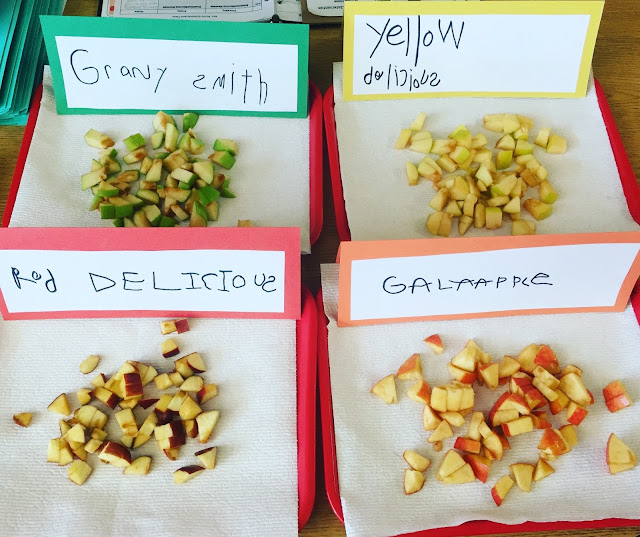They started looking closer and documenting what they noticed. They started asking questions and wondering about the apples. "Do they all have seeds?" "What colors can they be?" "Can they float?" "Why is it turning brown?"(Wondering if things sink or float is a consistent interest I am noticing with this group). We are keeping track of these wonderings so that we can answer their questions later!
Here is an observational drawing using oil pastels of a rotting apple. They are noticing it changing more every day.
We did an experiment to see if the apples would sink or float. The predictions were about half and half! They floated but we wonder why? If we throw it in the air it falls, but it doesn't in the water! We may revisit this in a future inquiry! They used their emerging writing skills as they recorded their predictions and the results.
After tasting, we made a graph to collect some data. I asked them what data this graph gives us. They said, "Green has most." "Gala has fewest." But then I asked them what that means. What does this data mean? I want them to extend the graph and connect it to the experience. "Most of us liked the Granny Smith apples the best." "11 of us like Granny Smith apples." This is very hard for them at first, but they are learning!
We set up a STEM challenge to get the kids to start using their critical thinking skills. "Can you build a bridge that can hold an apple?" They then started trying to build a bridge that could hold the most apples and then started trying to figure out how to improve their designs to make them more sturdy. Here are just a few of the designs!
Each table created a giant apple to show the different colors apples can be. This was the first small scale project where the kids worked as a team to show what they noticed. They had so much fun creating these. "This is the best day ever!" was heard more than once as they were working! If they loved working on these, I can't wait to do a large scale project with this group!
They started by mixing colors that would make the perfect matching color for their apple.
They looked closer at their apples and added the small details.
We incorporated writing as they came up with words to describe what they noticed about their apples and labeled them.
After exploring apples all that we could, they dictated what they learned to me as I typed it on the computer. They started shouting out all of the sight words that we have learned so far that were popping up on our sentences! They went up to the promethium board and pointed them out to me and asked if I would highlight them! Here is our list of what we have learned about apples.
I took all of our projects and displayed them out in the hallway to show what we did as we explored apples!
Here are some examples of labeling what they noticed on the inside of an apple and individual projects showing the seasons of an apple tree.
Because I use my own curriculum I make sure to post the standards worked on during the experiences in our inquiries. These are not the only standards worked on as we also have reading, writing, and math stations covering even more.
Here is the whole display in our hallway showing all that we did.
Next we will look closer at pumpkins as we continue to practice looking closer and showing what we see, think and wonder!



















































